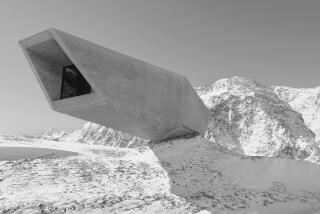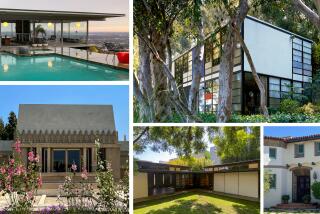Staircases to Somewhere
- Share via
As a simple means of getting from one level to another, stairs might seem mundane, but in Eva Jiricna’s new book “Staircases,” they appear as marvels of engineering and innovation. With 150 color and 100 black-and-white illustrations, “Staircases” (Watson-Guptill Publications, $45) shows how form and function can be combined with imagination to create lasting beauty and sometimes wonderment.
The book’s author, Czechoslovakian-born Jiricna, is one of Britain’s leading architects. Here, she explores the cultural resonance of staircases. She believes they “respond to the type of society for which they were built and, among other things, inform us about the existing state of the arts, fashion and technology.”
Beginning with a historical overview from the ancient world to the 20th century, Jiricna shows how stairs evolved out of necessary yet rudimentary paths up hillsides to landscaped staircases and then to ones made of wood and stone and other materials.
Following the overview are themed chapters, featuring landscape staircases, glass stairs, staircases as sculpture and more--all built within the last 25 years and designed by 50 different architects, among them Tadao Ando, Ron Arad, Renzo Piano and Phillipe Starck.
There seems no limit to inventiveness in staircase design, whether in ancient stepped terraces of the Inca city of Machu Picchu, Peru, or the 1997 floating staircase by Guillaume Saalburg in a private Paris apartment.
They can be as ornate as one at the Paris Opera, finished in 1875 by Charles Garnier, as humble as simple wooden stairs outside a house in Italy’s Veneto region and as contemporary as the 1989 I.M. Pei & Partners staircase for the Louvre in Paris.
Glass and steel staircases Jiricna designed for retailers Joseph in London and Joan & David in Paris also are illustrated and commented on. As an architect, Jiricna understands the artistic and functional concerns involved in staircase design, particularly with today’s exacting standards for safety and maintenance and those that address the needs of the disabled.
The text for each design explains the motivations, method of construction and technology used to achieve the desired result. Jiricna describes the book as reflecting her personal choices, rather than a definitive study, and perhaps that’s what makes it so illuminating. Through her commentary, the reader is given insights into an architect’s mind as well as a better understanding of the medium.
On Wednesday, from 6:30 p.m. to 8 p.m., Sotheby’s in Beverly Hills is sponsoring a lecture by Barbara Deisroth, senior vice president of decorative arts at Sotheby’s, New York, titled “Mid-Century Design: Custom-Made Furniture From France and America.” Deisroth will discuss how midcentury design incorporates unique furniture by designers like Jean Royere, Charlotte Perriand and Jean Prove. Their custom pieces, made for select clients, will be contrasted with the mass-market furniture of Knoll and Eames. Lesser-known designers of quality furniture and decorative objects also will be discussed. The lecture is free, but reservations are requested. Sotheby’s is at 9665 Wilshire Blvd., Beverly Hills. Call (310) 274-0340.
Echo Park Pottery will have a free open house at ceramicist Peter Shire’s studio on Sunday, from 10 a.m. to 3 p.m. and on Dec. 15, from 1 to 5 p.m. Many distinctive pieces of brightly colored Echo Park pottery in a variety of shapes will be for sale. Sales benefit the Citizens Committee to Save Elysian Park. The studio is at 1850 Echo Park Ave., Los Angeles. Call (323) 662-8067.
More to Read
Sign up for The Wild
We’ll help you find the best places to hike, bike and run, as well as the perfect silent spots for meditation and yoga.
You may occasionally receive promotional content from the Los Angeles Times.






